Commercial and Corporations Law: Business Registration and Structure
VerifiedAdded on 2020/03/28
|8
|2602
|60
Homework Assignment
AI Summary
This assignment solution addresses key concepts in commercial and corporations law, focusing on business structures and their implications. The solution explores the process of business registration, including obtaining an Australian Business Number (ABN) and registering a business name with ASIC. It examines the characteristics that distinguish a company from other structures, such as its legal entity status, perpetual succession, and limited liability. The assignment compares the advantages and disadvantages of different business structures, including sole trader, partnership, and company, considering factors like liability, transferability of ownership, and tax implications. It also analyzes the impact of adding new partners or members to a business, highlighting the flexibility of a company structure compared to a partnership. Furthermore, the solution addresses the protection of personal assets and the reporting obligations associated with each business structure. The document draws on various legal sources and references to support its analysis. This assignment is a valuable resource for students studying business law, providing insights into the practical application of legal principles in business operations.

Commercial & Corporations Law
STUDENT ID:
[Pick the date]
STUDENT ID:
[Pick the date]
Paraphrase This Document
Need a fresh take? Get an instant paraphrase of this document with our AI Paraphraser
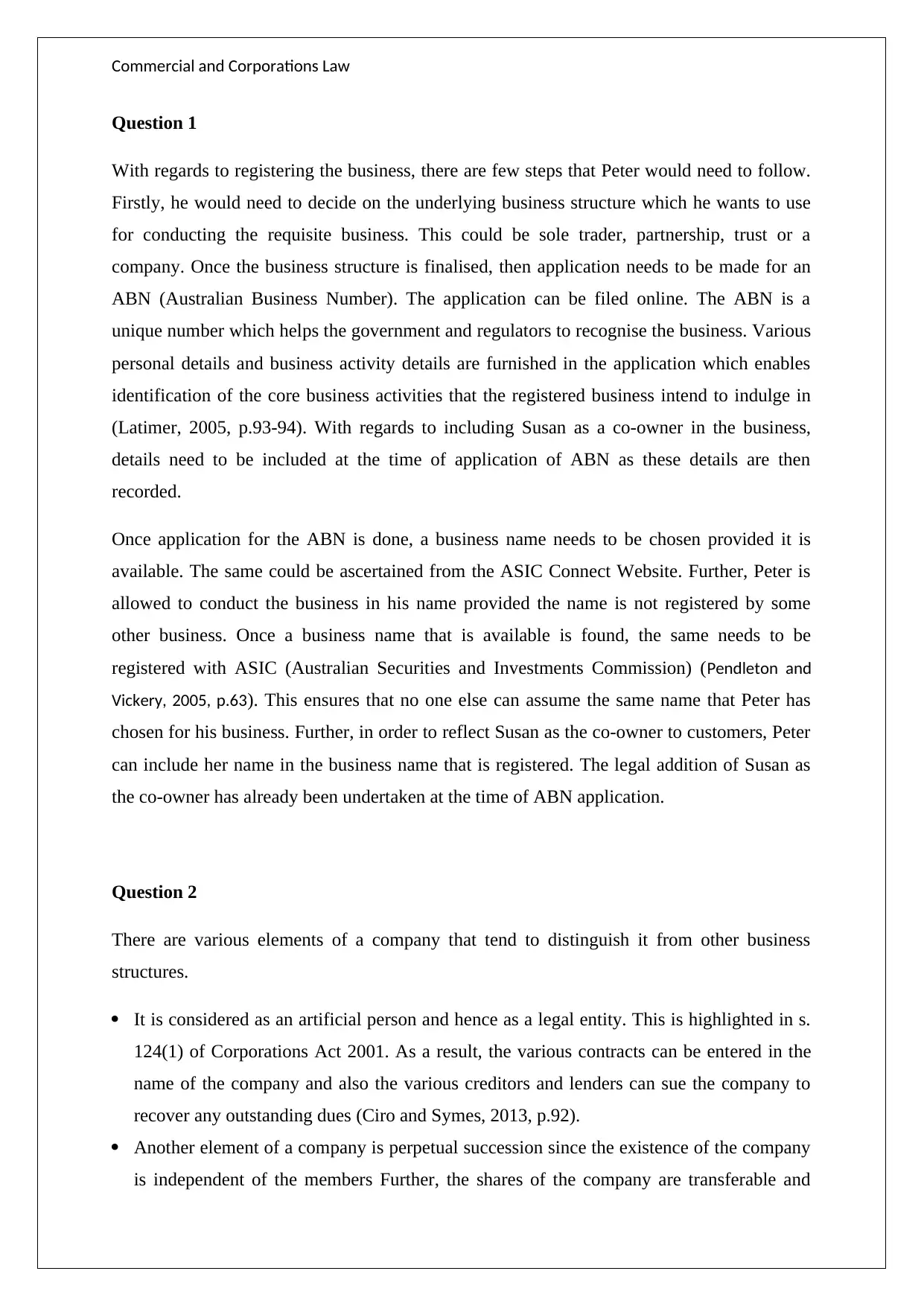
Commercial and Corporations Law
Question 1
With regards to registering the business, there are few steps that Peter would need to follow.
Firstly, he would need to decide on the underlying business structure which he wants to use
for conducting the requisite business. This could be sole trader, partnership, trust or a
company. Once the business structure is finalised, then application needs to be made for an
ABN (Australian Business Number). The application can be filed online. The ABN is a
unique number which helps the government and regulators to recognise the business. Various
personal details and business activity details are furnished in the application which enables
identification of the core business activities that the registered business intend to indulge in
(Latimer, 2005, p.93-94). With regards to including Susan as a co-owner in the business,
details need to be included at the time of application of ABN as these details are then
recorded.
Once application for the ABN is done, a business name needs to be chosen provided it is
available. The same could be ascertained from the ASIC Connect Website. Further, Peter is
allowed to conduct the business in his name provided the name is not registered by some
other business. Once a business name that is available is found, the same needs to be
registered with ASIC (Australian Securities and Investments Commission) (Pendleton and
Vickery, 2005, p.63). This ensures that no one else can assume the same name that Peter has
chosen for his business. Further, in order to reflect Susan as the co-owner to customers, Peter
can include her name in the business name that is registered. The legal addition of Susan as
the co-owner has already been undertaken at the time of ABN application.
Question 2
There are various elements of a company that tend to distinguish it from other business
structures.
It is considered as an artificial person and hence as a legal entity. This is highlighted in s.
124(1) of Corporations Act 2001. As a result, the various contracts can be entered in the
name of the company and also the various creditors and lenders can sue the company to
recover any outstanding dues (Ciro and Symes, 2013, p.92).
Another element of a company is perpetual succession since the existence of the company
is independent of the members Further, the shares of the company are transferable and
Question 1
With regards to registering the business, there are few steps that Peter would need to follow.
Firstly, he would need to decide on the underlying business structure which he wants to use
for conducting the requisite business. This could be sole trader, partnership, trust or a
company. Once the business structure is finalised, then application needs to be made for an
ABN (Australian Business Number). The application can be filed online. The ABN is a
unique number which helps the government and regulators to recognise the business. Various
personal details and business activity details are furnished in the application which enables
identification of the core business activities that the registered business intend to indulge in
(Latimer, 2005, p.93-94). With regards to including Susan as a co-owner in the business,
details need to be included at the time of application of ABN as these details are then
recorded.
Once application for the ABN is done, a business name needs to be chosen provided it is
available. The same could be ascertained from the ASIC Connect Website. Further, Peter is
allowed to conduct the business in his name provided the name is not registered by some
other business. Once a business name that is available is found, the same needs to be
registered with ASIC (Australian Securities and Investments Commission) (Pendleton and
Vickery, 2005, p.63). This ensures that no one else can assume the same name that Peter has
chosen for his business. Further, in order to reflect Susan as the co-owner to customers, Peter
can include her name in the business name that is registered. The legal addition of Susan as
the co-owner has already been undertaken at the time of ABN application.
Question 2
There are various elements of a company that tend to distinguish it from other business
structures.
It is considered as an artificial person and hence as a legal entity. This is highlighted in s.
124(1) of Corporations Act 2001. As a result, the various contracts can be entered in the
name of the company and also the various creditors and lenders can sue the company to
recover any outstanding dues (Ciro and Symes, 2013, p.92).
Another element of a company is perpetual succession since the existence of the company
is independent of the members Further, the shares of the company are transferable and
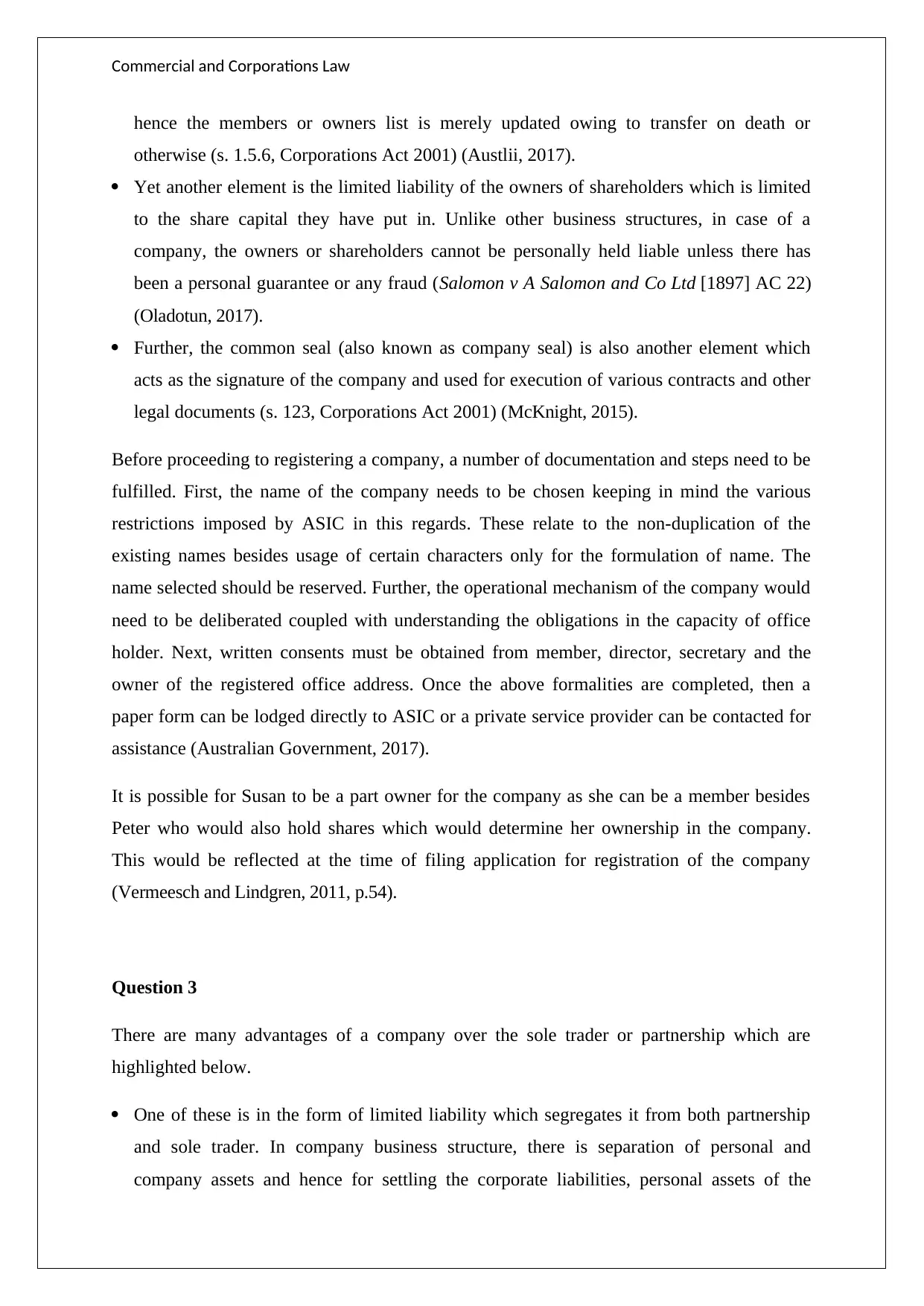
Commercial and Corporations Law
hence the members or owners list is merely updated owing to transfer on death or
otherwise (s. 1.5.6, Corporations Act 2001) (Austlii, 2017).
Yet another element is the limited liability of the owners of shareholders which is limited
to the share capital they have put in. Unlike other business structures, in case of a
company, the owners or shareholders cannot be personally held liable unless there has
been a personal guarantee or any fraud (Salomon v A Salomon and Co Ltd [1897] AC 22)
(Oladotun, 2017).
Further, the common seal (also known as company seal) is also another element which
acts as the signature of the company and used for execution of various contracts and other
legal documents (s. 123, Corporations Act 2001) (McKnight, 2015).
Before proceeding to registering a company, a number of documentation and steps need to be
fulfilled. First, the name of the company needs to be chosen keeping in mind the various
restrictions imposed by ASIC in this regards. These relate to the non-duplication of the
existing names besides usage of certain characters only for the formulation of name. The
name selected should be reserved. Further, the operational mechanism of the company would
need to be deliberated coupled with understanding the obligations in the capacity of office
holder. Next, written consents must be obtained from member, director, secretary and the
owner of the registered office address. Once the above formalities are completed, then a
paper form can be lodged directly to ASIC or a private service provider can be contacted for
assistance (Australian Government, 2017).
It is possible for Susan to be a part owner for the company as she can be a member besides
Peter who would also hold shares which would determine her ownership in the company.
This would be reflected at the time of filing application for registration of the company
(Vermeesch and Lindgren, 2011, p.54).
Question 3
There are many advantages of a company over the sole trader or partnership which are
highlighted below.
One of these is in the form of limited liability which segregates it from both partnership
and sole trader. In company business structure, there is separation of personal and
company assets and hence for settling the corporate liabilities, personal assets of the
hence the members or owners list is merely updated owing to transfer on death or
otherwise (s. 1.5.6, Corporations Act 2001) (Austlii, 2017).
Yet another element is the limited liability of the owners of shareholders which is limited
to the share capital they have put in. Unlike other business structures, in case of a
company, the owners or shareholders cannot be personally held liable unless there has
been a personal guarantee or any fraud (Salomon v A Salomon and Co Ltd [1897] AC 22)
(Oladotun, 2017).
Further, the common seal (also known as company seal) is also another element which
acts as the signature of the company and used for execution of various contracts and other
legal documents (s. 123, Corporations Act 2001) (McKnight, 2015).
Before proceeding to registering a company, a number of documentation and steps need to be
fulfilled. First, the name of the company needs to be chosen keeping in mind the various
restrictions imposed by ASIC in this regards. These relate to the non-duplication of the
existing names besides usage of certain characters only for the formulation of name. The
name selected should be reserved. Further, the operational mechanism of the company would
need to be deliberated coupled with understanding the obligations in the capacity of office
holder. Next, written consents must be obtained from member, director, secretary and the
owner of the registered office address. Once the above formalities are completed, then a
paper form can be lodged directly to ASIC or a private service provider can be contacted for
assistance (Australian Government, 2017).
It is possible for Susan to be a part owner for the company as she can be a member besides
Peter who would also hold shares which would determine her ownership in the company.
This would be reflected at the time of filing application for registration of the company
(Vermeesch and Lindgren, 2011, p.54).
Question 3
There are many advantages of a company over the sole trader or partnership which are
highlighted below.
One of these is in the form of limited liability which segregates it from both partnership
and sole trader. In company business structure, there is separation of personal and
company assets and hence for settling the corporate liabilities, personal assets of the
⊘ This is a preview!⊘
Do you want full access?
Subscribe today to unlock all pages.

Trusted by 1+ million students worldwide
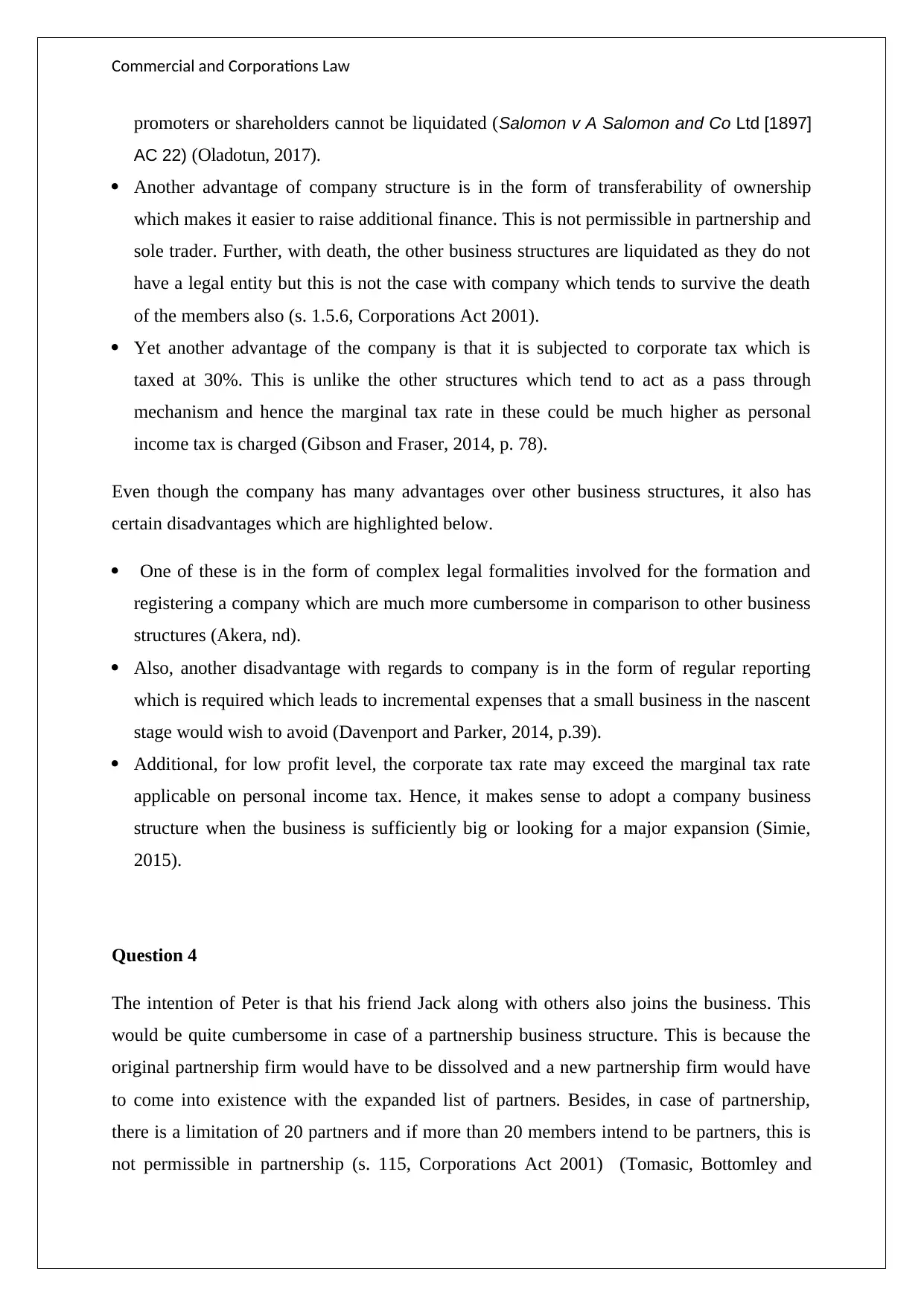
Commercial and Corporations Law
promoters or shareholders cannot be liquidated (Salomon v A Salomon and Co Ltd [1897]
AC 22) (Oladotun, 2017).
Another advantage of company structure is in the form of transferability of ownership
which makes it easier to raise additional finance. This is not permissible in partnership and
sole trader. Further, with death, the other business structures are liquidated as they do not
have a legal entity but this is not the case with company which tends to survive the death
of the members also (s. 1.5.6, Corporations Act 2001).
Yet another advantage of the company is that it is subjected to corporate tax which is
taxed at 30%. This is unlike the other structures which tend to act as a pass through
mechanism and hence the marginal tax rate in these could be much higher as personal
income tax is charged (Gibson and Fraser, 2014, p. 78).
Even though the company has many advantages over other business structures, it also has
certain disadvantages which are highlighted below.
One of these is in the form of complex legal formalities involved for the formation and
registering a company which are much more cumbersome in comparison to other business
structures (Akera, nd).
Also, another disadvantage with regards to company is in the form of regular reporting
which is required which leads to incremental expenses that a small business in the nascent
stage would wish to avoid (Davenport and Parker, 2014, p.39).
Additional, for low profit level, the corporate tax rate may exceed the marginal tax rate
applicable on personal income tax. Hence, it makes sense to adopt a company business
structure when the business is sufficiently big or looking for a major expansion (Simie,
2015).
Question 4
The intention of Peter is that his friend Jack along with others also joins the business. This
would be quite cumbersome in case of a partnership business structure. This is because the
original partnership firm would have to be dissolved and a new partnership firm would have
to come into existence with the expanded list of partners. Besides, in case of partnership,
there is a limitation of 20 partners and if more than 20 members intend to be partners, this is
not permissible in partnership (s. 115, Corporations Act 2001) (Tomasic, Bottomley and
promoters or shareholders cannot be liquidated (Salomon v A Salomon and Co Ltd [1897]
AC 22) (Oladotun, 2017).
Another advantage of company structure is in the form of transferability of ownership
which makes it easier to raise additional finance. This is not permissible in partnership and
sole trader. Further, with death, the other business structures are liquidated as they do not
have a legal entity but this is not the case with company which tends to survive the death
of the members also (s. 1.5.6, Corporations Act 2001).
Yet another advantage of the company is that it is subjected to corporate tax which is
taxed at 30%. This is unlike the other structures which tend to act as a pass through
mechanism and hence the marginal tax rate in these could be much higher as personal
income tax is charged (Gibson and Fraser, 2014, p. 78).
Even though the company has many advantages over other business structures, it also has
certain disadvantages which are highlighted below.
One of these is in the form of complex legal formalities involved for the formation and
registering a company which are much more cumbersome in comparison to other business
structures (Akera, nd).
Also, another disadvantage with regards to company is in the form of regular reporting
which is required which leads to incremental expenses that a small business in the nascent
stage would wish to avoid (Davenport and Parker, 2014, p.39).
Additional, for low profit level, the corporate tax rate may exceed the marginal tax rate
applicable on personal income tax. Hence, it makes sense to adopt a company business
structure when the business is sufficiently big or looking for a major expansion (Simie,
2015).
Question 4
The intention of Peter is that his friend Jack along with others also joins the business. This
would be quite cumbersome in case of a partnership business structure. This is because the
original partnership firm would have to be dissolved and a new partnership firm would have
to come into existence with the expanded list of partners. Besides, in case of partnership,
there is a limitation of 20 partners and if more than 20 members intend to be partners, this is
not permissible in partnership (s. 115, Corporations Act 2001) (Tomasic, Bottomley and
Paraphrase This Document
Need a fresh take? Get an instant paraphrase of this document with our AI Paraphraser
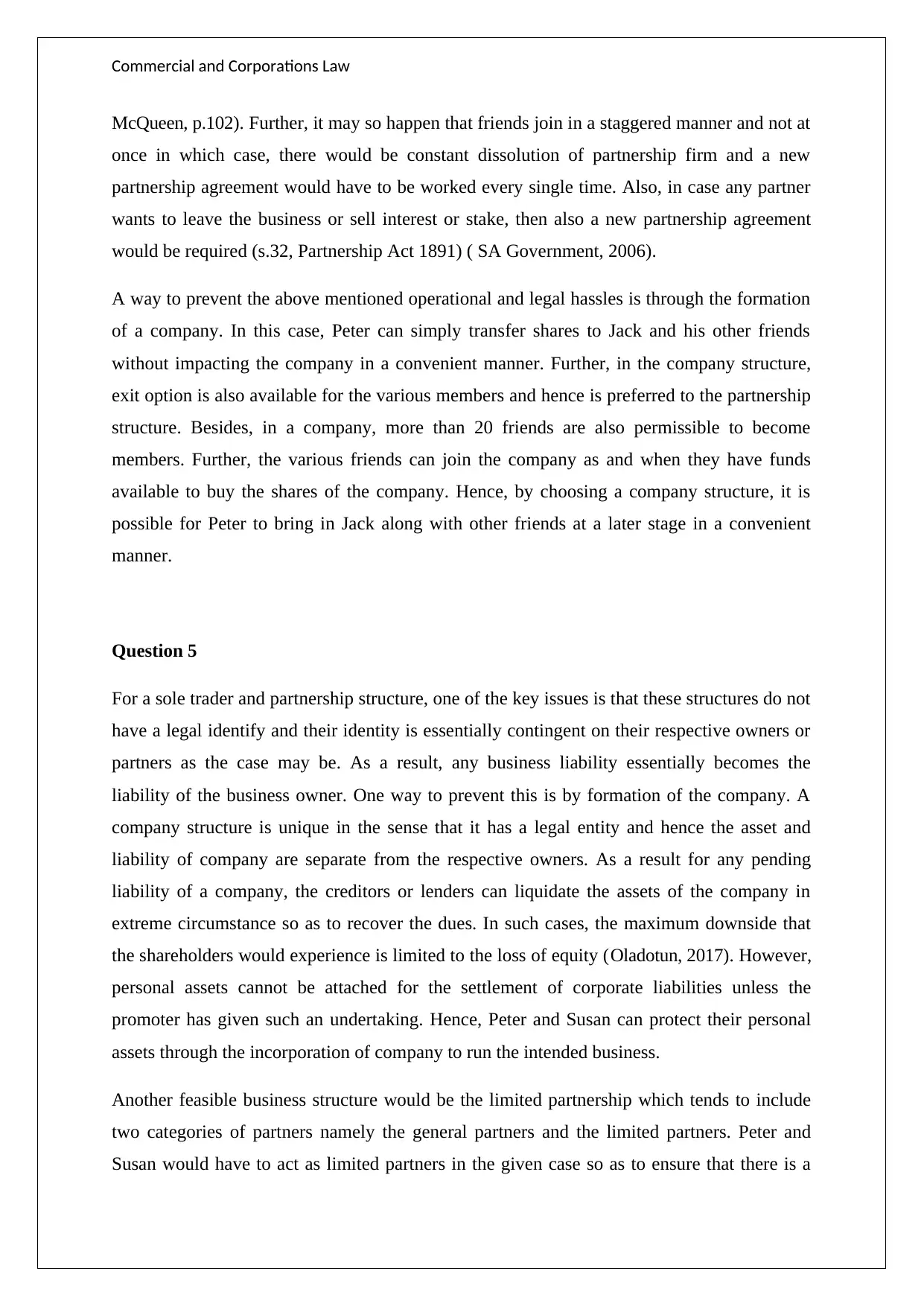
Commercial and Corporations Law
McQueen, p.102). Further, it may so happen that friends join in a staggered manner and not at
once in which case, there would be constant dissolution of partnership firm and a new
partnership agreement would have to be worked every single time. Also, in case any partner
wants to leave the business or sell interest or stake, then also a new partnership agreement
would be required (s.32, Partnership Act 1891) ( SA Government, 2006).
A way to prevent the above mentioned operational and legal hassles is through the formation
of a company. In this case, Peter can simply transfer shares to Jack and his other friends
without impacting the company in a convenient manner. Further, in the company structure,
exit option is also available for the various members and hence is preferred to the partnership
structure. Besides, in a company, more than 20 friends are also permissible to become
members. Further, the various friends can join the company as and when they have funds
available to buy the shares of the company. Hence, by choosing a company structure, it is
possible for Peter to bring in Jack along with other friends at a later stage in a convenient
manner.
Question 5
For a sole trader and partnership structure, one of the key issues is that these structures do not
have a legal identify and their identity is essentially contingent on their respective owners or
partners as the case may be. As a result, any business liability essentially becomes the
liability of the business owner. One way to prevent this is by formation of the company. A
company structure is unique in the sense that it has a legal entity and hence the asset and
liability of company are separate from the respective owners. As a result for any pending
liability of a company, the creditors or lenders can liquidate the assets of the company in
extreme circumstance so as to recover the dues. In such cases, the maximum downside that
the shareholders would experience is limited to the loss of equity (Oladotun, 2017). However,
personal assets cannot be attached for the settlement of corporate liabilities unless the
promoter has given such an undertaking. Hence, Peter and Susan can protect their personal
assets through the incorporation of company to run the intended business.
Another feasible business structure would be the limited partnership which tends to include
two categories of partners namely the general partners and the limited partners. Peter and
Susan would have to act as limited partners in the given case so as to ensure that there is a
McQueen, p.102). Further, it may so happen that friends join in a staggered manner and not at
once in which case, there would be constant dissolution of partnership firm and a new
partnership agreement would have to be worked every single time. Also, in case any partner
wants to leave the business or sell interest or stake, then also a new partnership agreement
would be required (s.32, Partnership Act 1891) ( SA Government, 2006).
A way to prevent the above mentioned operational and legal hassles is through the formation
of a company. In this case, Peter can simply transfer shares to Jack and his other friends
without impacting the company in a convenient manner. Further, in the company structure,
exit option is also available for the various members and hence is preferred to the partnership
structure. Besides, in a company, more than 20 friends are also permissible to become
members. Further, the various friends can join the company as and when they have funds
available to buy the shares of the company. Hence, by choosing a company structure, it is
possible for Peter to bring in Jack along with other friends at a later stage in a convenient
manner.
Question 5
For a sole trader and partnership structure, one of the key issues is that these structures do not
have a legal identify and their identity is essentially contingent on their respective owners or
partners as the case may be. As a result, any business liability essentially becomes the
liability of the business owner. One way to prevent this is by formation of the company. A
company structure is unique in the sense that it has a legal entity and hence the asset and
liability of company are separate from the respective owners. As a result for any pending
liability of a company, the creditors or lenders can liquidate the assets of the company in
extreme circumstance so as to recover the dues. In such cases, the maximum downside that
the shareholders would experience is limited to the loss of equity (Oladotun, 2017). However,
personal assets cannot be attached for the settlement of corporate liabilities unless the
promoter has given such an undertaking. Hence, Peter and Susan can protect their personal
assets through the incorporation of company to run the intended business.
Another feasible business structure would be the limited partnership which tends to include
two categories of partners namely the general partners and the limited partners. Peter and
Susan would have to act as limited partners in the given case so as to ensure that there is a
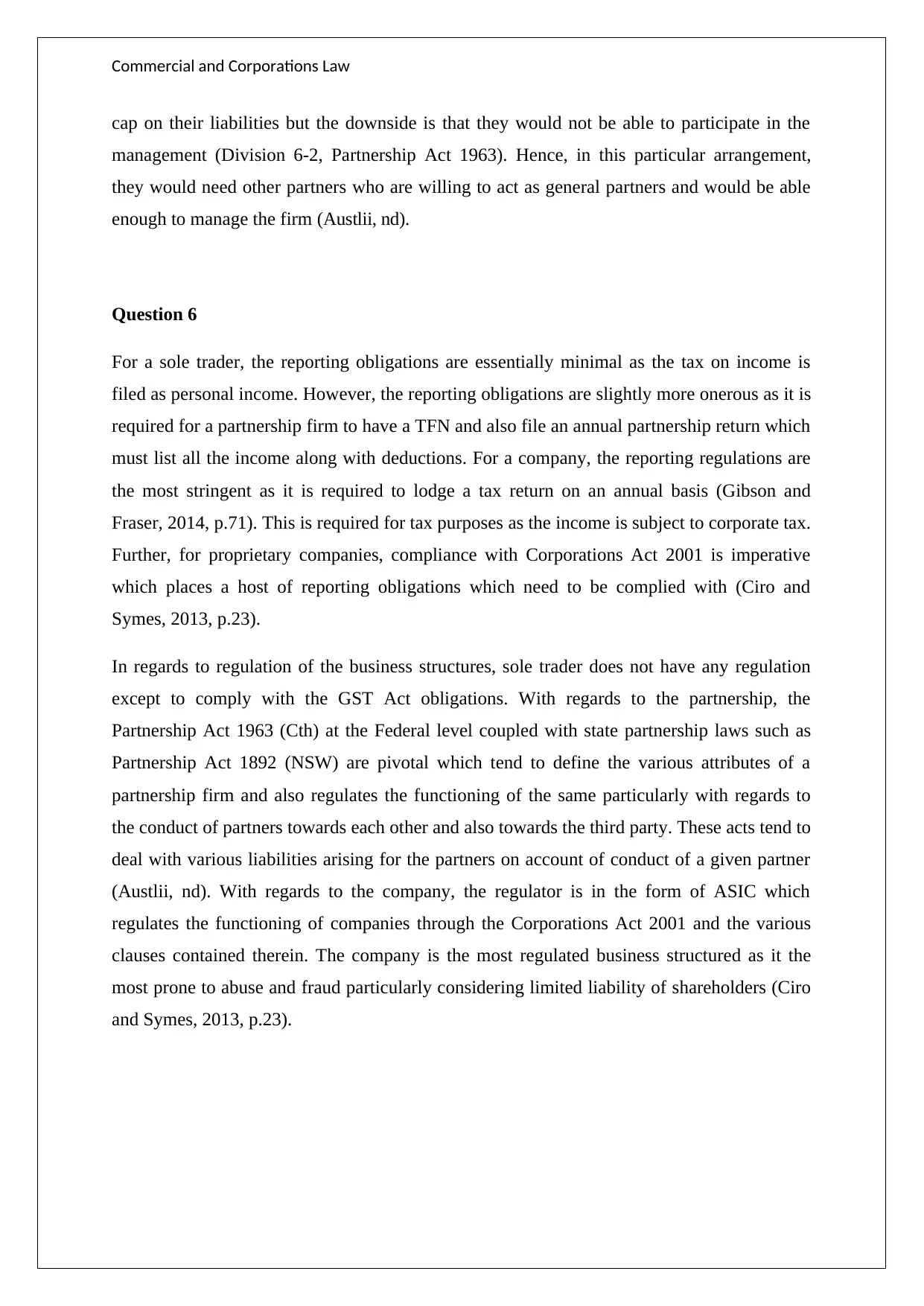
Commercial and Corporations Law
cap on their liabilities but the downside is that they would not be able to participate in the
management (Division 6-2, Partnership Act 1963). Hence, in this particular arrangement,
they would need other partners who are willing to act as general partners and would be able
enough to manage the firm (Austlii, nd).
Question 6
For a sole trader, the reporting obligations are essentially minimal as the tax on income is
filed as personal income. However, the reporting obligations are slightly more onerous as it is
required for a partnership firm to have a TFN and also file an annual partnership return which
must list all the income along with deductions. For a company, the reporting regulations are
the most stringent as it is required to lodge a tax return on an annual basis (Gibson and
Fraser, 2014, p.71). This is required for tax purposes as the income is subject to corporate tax.
Further, for proprietary companies, compliance with Corporations Act 2001 is imperative
which places a host of reporting obligations which need to be complied with (Ciro and
Symes, 2013, p.23).
In regards to regulation of the business structures, sole trader does not have any regulation
except to comply with the GST Act obligations. With regards to the partnership, the
Partnership Act 1963 (Cth) at the Federal level coupled with state partnership laws such as
Partnership Act 1892 (NSW) are pivotal which tend to define the various attributes of a
partnership firm and also regulates the functioning of the same particularly with regards to
the conduct of partners towards each other and also towards the third party. These acts tend to
deal with various liabilities arising for the partners on account of conduct of a given partner
(Austlii, nd). With regards to the company, the regulator is in the form of ASIC which
regulates the functioning of companies through the Corporations Act 2001 and the various
clauses contained therein. The company is the most regulated business structured as it the
most prone to abuse and fraud particularly considering limited liability of shareholders (Ciro
and Symes, 2013, p.23).
cap on their liabilities but the downside is that they would not be able to participate in the
management (Division 6-2, Partnership Act 1963). Hence, in this particular arrangement,
they would need other partners who are willing to act as general partners and would be able
enough to manage the firm (Austlii, nd).
Question 6
For a sole trader, the reporting obligations are essentially minimal as the tax on income is
filed as personal income. However, the reporting obligations are slightly more onerous as it is
required for a partnership firm to have a TFN and also file an annual partnership return which
must list all the income along with deductions. For a company, the reporting regulations are
the most stringent as it is required to lodge a tax return on an annual basis (Gibson and
Fraser, 2014, p.71). This is required for tax purposes as the income is subject to corporate tax.
Further, for proprietary companies, compliance with Corporations Act 2001 is imperative
which places a host of reporting obligations which need to be complied with (Ciro and
Symes, 2013, p.23).
In regards to regulation of the business structures, sole trader does not have any regulation
except to comply with the GST Act obligations. With regards to the partnership, the
Partnership Act 1963 (Cth) at the Federal level coupled with state partnership laws such as
Partnership Act 1892 (NSW) are pivotal which tend to define the various attributes of a
partnership firm and also regulates the functioning of the same particularly with regards to
the conduct of partners towards each other and also towards the third party. These acts tend to
deal with various liabilities arising for the partners on account of conduct of a given partner
(Austlii, nd). With regards to the company, the regulator is in the form of ASIC which
regulates the functioning of companies through the Corporations Act 2001 and the various
clauses contained therein. The company is the most regulated business structured as it the
most prone to abuse and fraud particularly considering limited liability of shareholders (Ciro
and Symes, 2013, p.23).
⊘ This is a preview!⊘
Do you want full access?
Subscribe today to unlock all pages.

Trusted by 1+ million students worldwide
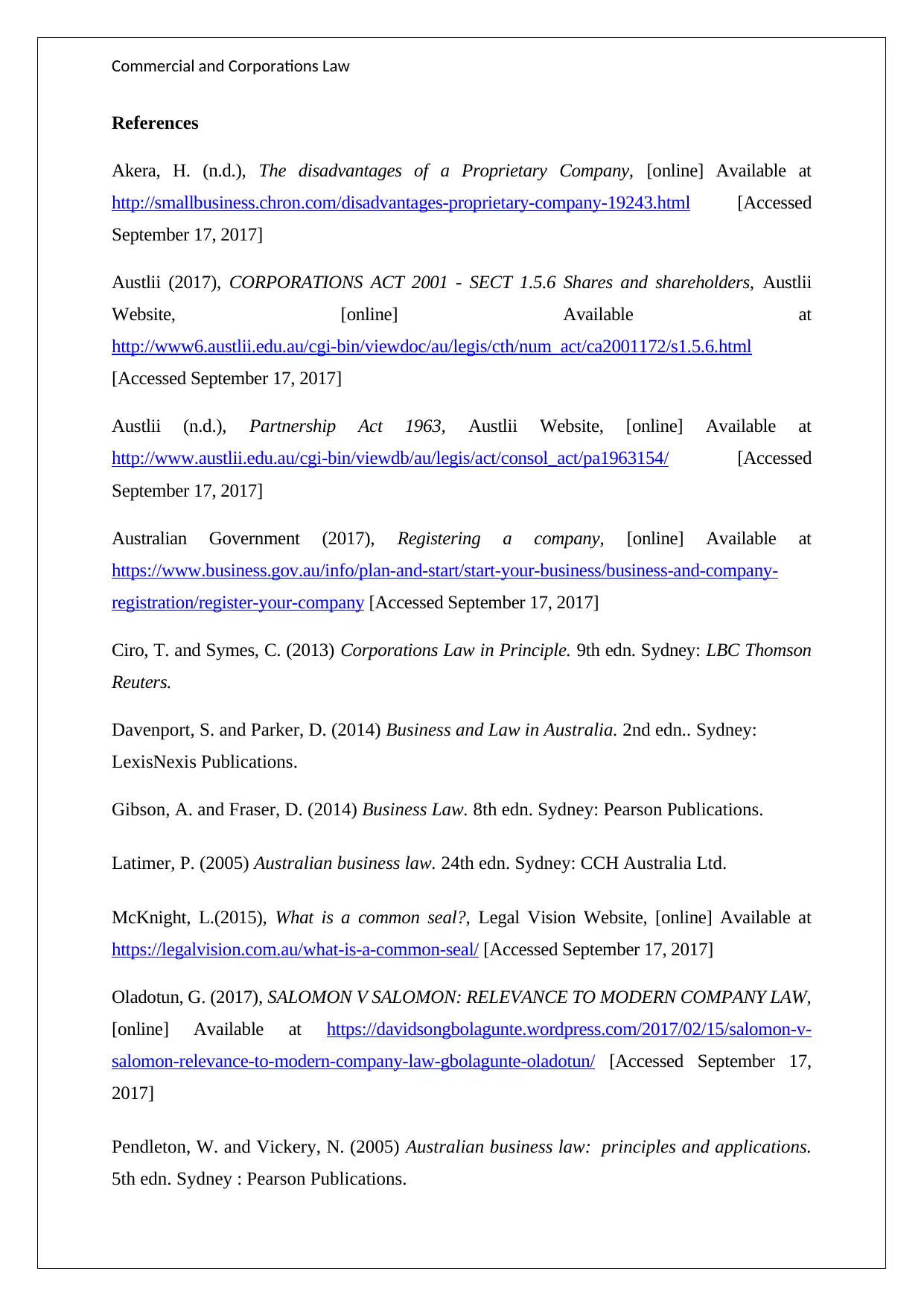
Commercial and Corporations Law
References
Akera, H. (n.d.), The disadvantages of a Proprietary Company, [online] Available at
http://smallbusiness.chron.com/disadvantages-proprietary-company-19243.html [Accessed
September 17, 2017]
Austlii (2017), CORPORATIONS ACT 2001 - SECT 1.5.6 Shares and shareholders, Austlii
Website, [online] Available at
http://www6.austlii.edu.au/cgi-bin/viewdoc/au/legis/cth/num_act/ca2001172/s1.5.6.html
[Accessed September 17, 2017]
Austlii (n.d.), Partnership Act 1963, Austlii Website, [online] Available at
http://www.austlii.edu.au/cgi-bin/viewdb/au/legis/act/consol_act/pa1963154/ [Accessed
September 17, 2017]
Australian Government (2017), Registering a company, [online] Available at
https://www.business.gov.au/info/plan-and-start/start-your-business/business-and-company-
registration/register-your-company [Accessed September 17, 2017]
Ciro, T. and Symes, C. (2013) Corporations Law in Principle. 9th edn. Sydney: LBC Thomson
Reuters.
Davenport, S. and Parker, D. (2014) Business and Law in Australia. 2nd edn.. Sydney:
LexisNexis Publications.
Gibson, A. and Fraser, D. (2014) Business Law. 8th edn. Sydney: Pearson Publications.
Latimer, P. (2005) Australian business law. 24th edn. Sydney: CCH Australia Ltd.
McKnight, L.(2015), What is a common seal?, Legal Vision Website, [online] Available at
https://legalvision.com.au/what-is-a-common-seal/ [Accessed September 17, 2017]
Oladotun, G. (2017), SALOMON V SALOMON: RELEVANCE TO MODERN COMPANY LAW,
[online] Available at https://davidsongbolagunte.wordpress.com/2017/02/15/salomon-v-
salomon-relevance-to-modern-company-law-gbolagunte-oladotun/ [Accessed September 17,
2017]
Pendleton, W. and Vickery, N. (2005) Australian business law: principles and applications.
5th edn. Sydney : Pearson Publications.
References
Akera, H. (n.d.), The disadvantages of a Proprietary Company, [online] Available at
http://smallbusiness.chron.com/disadvantages-proprietary-company-19243.html [Accessed
September 17, 2017]
Austlii (2017), CORPORATIONS ACT 2001 - SECT 1.5.6 Shares and shareholders, Austlii
Website, [online] Available at
http://www6.austlii.edu.au/cgi-bin/viewdoc/au/legis/cth/num_act/ca2001172/s1.5.6.html
[Accessed September 17, 2017]
Austlii (n.d.), Partnership Act 1963, Austlii Website, [online] Available at
http://www.austlii.edu.au/cgi-bin/viewdb/au/legis/act/consol_act/pa1963154/ [Accessed
September 17, 2017]
Australian Government (2017), Registering a company, [online] Available at
https://www.business.gov.au/info/plan-and-start/start-your-business/business-and-company-
registration/register-your-company [Accessed September 17, 2017]
Ciro, T. and Symes, C. (2013) Corporations Law in Principle. 9th edn. Sydney: LBC Thomson
Reuters.
Davenport, S. and Parker, D. (2014) Business and Law in Australia. 2nd edn.. Sydney:
LexisNexis Publications.
Gibson, A. and Fraser, D. (2014) Business Law. 8th edn. Sydney: Pearson Publications.
Latimer, P. (2005) Australian business law. 24th edn. Sydney: CCH Australia Ltd.
McKnight, L.(2015), What is a common seal?, Legal Vision Website, [online] Available at
https://legalvision.com.au/what-is-a-common-seal/ [Accessed September 17, 2017]
Oladotun, G. (2017), SALOMON V SALOMON: RELEVANCE TO MODERN COMPANY LAW,
[online] Available at https://davidsongbolagunte.wordpress.com/2017/02/15/salomon-v-
salomon-relevance-to-modern-company-law-gbolagunte-oladotun/ [Accessed September 17,
2017]
Pendleton, W. and Vickery, N. (2005) Australian business law: principles and applications.
5th edn. Sydney : Pearson Publications.
Paraphrase This Document
Need a fresh take? Get an instant paraphrase of this document with our AI Paraphraser
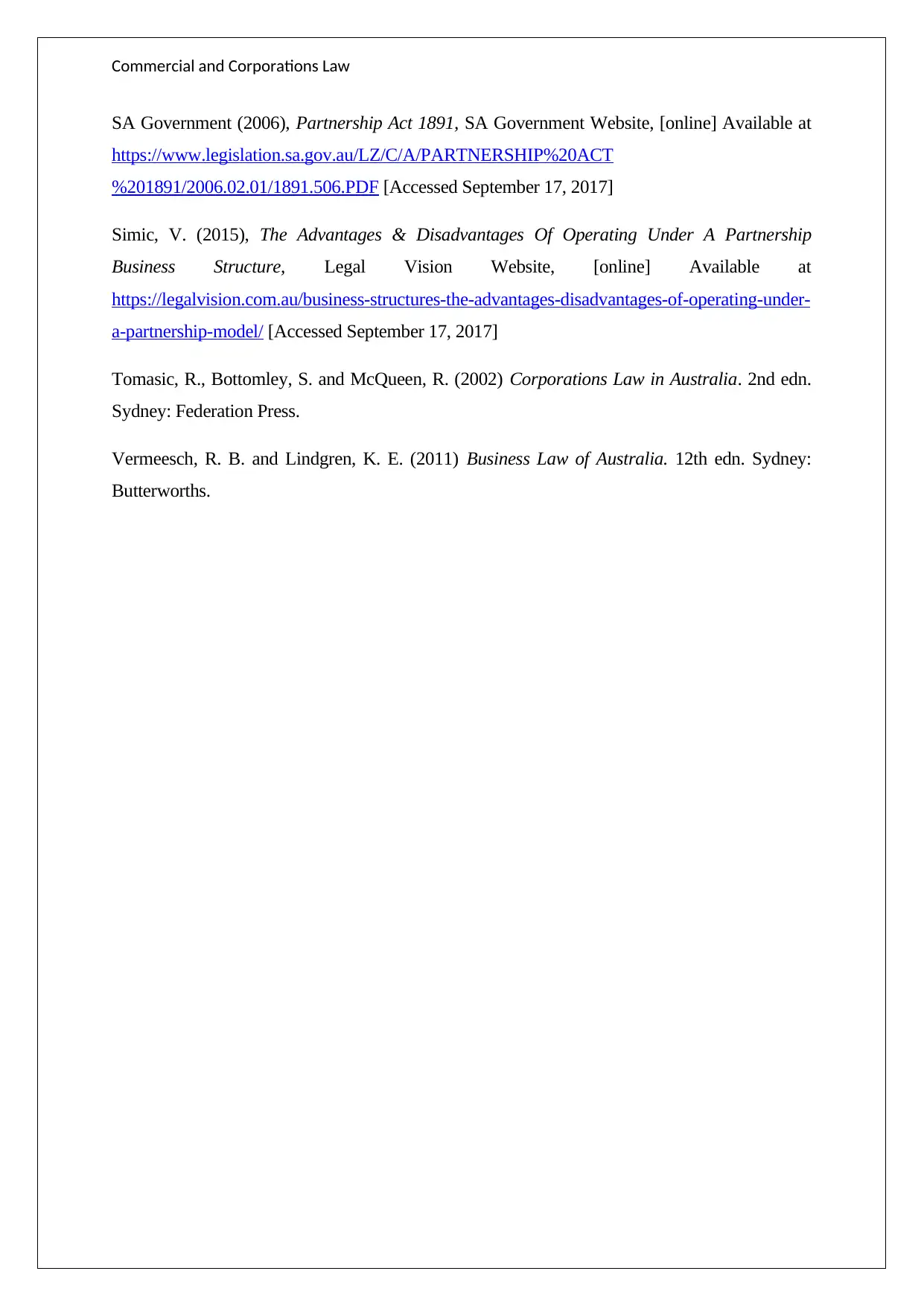
Commercial and Corporations Law
SA Government (2006), Partnership Act 1891, SA Government Website, [online] Available at
https://www.legislation.sa.gov.au/LZ/C/A/PARTNERSHIP%20ACT
%201891/2006.02.01/1891.506.PDF [Accessed September 17, 2017]
Simic, V. (2015), The Advantages & Disadvantages Of Operating Under A Partnership
Business Structure, Legal Vision Website, [online] Available at
https://legalvision.com.au/business-structures-the-advantages-disadvantages-of-operating-under-
a-partnership-model/ [Accessed September 17, 2017]
Tomasic, R., Bottomley, S. and McQueen, R. (2002) Corporations Law in Australia. 2nd edn.
Sydney: Federation Press.
Vermeesch, R. B. and Lindgren, K. E. (2011) Business Law of Australia. 12th edn. Sydney:
Butterworths.
SA Government (2006), Partnership Act 1891, SA Government Website, [online] Available at
https://www.legislation.sa.gov.au/LZ/C/A/PARTNERSHIP%20ACT
%201891/2006.02.01/1891.506.PDF [Accessed September 17, 2017]
Simic, V. (2015), The Advantages & Disadvantages Of Operating Under A Partnership
Business Structure, Legal Vision Website, [online] Available at
https://legalvision.com.au/business-structures-the-advantages-disadvantages-of-operating-under-
a-partnership-model/ [Accessed September 17, 2017]
Tomasic, R., Bottomley, S. and McQueen, R. (2002) Corporations Law in Australia. 2nd edn.
Sydney: Federation Press.
Vermeesch, R. B. and Lindgren, K. E. (2011) Business Law of Australia. 12th edn. Sydney:
Butterworths.
1 out of 8
Related Documents
Your All-in-One AI-Powered Toolkit for Academic Success.
+13062052269
info@desklib.com
Available 24*7 on WhatsApp / Email
![[object Object]](/_next/static/media/star-bottom.7253800d.svg)
Unlock your academic potential
Copyright © 2020–2025 A2Z Services. All Rights Reserved. Developed and managed by ZUCOL.




